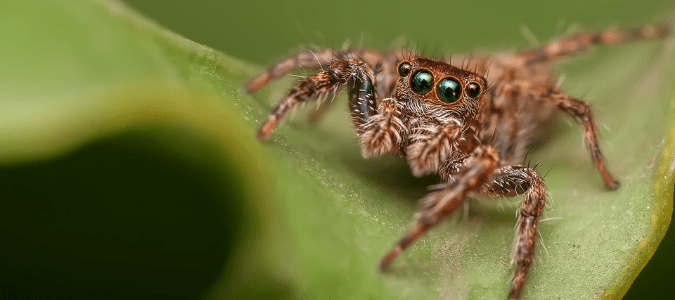
Arachnophobia is widespread among people all over the world, including in Florida. As a matter of fact, some of the most common Florida spiders seem to be extra terrifying. Despite their sometimes frightening appearance, many of these arachnids are not dangerous—at least not to homeowners. However, the ability to identify those which can hurt you and those which can’t will give you peace of mind and help avoid any medical emergencies.
Here’s a list of the most common species found throughout the Sunshine State. Thankfully, these varieties aren’t dangerous to humans:
Crab Spiders
Don’t confuse this arachnid with the spiny-backed orb weaver, which is shaped like a crab. This type of spider gets its name from the way it holds its front two pairs of legs to the side, like crab pincers.
Crab spiders also tend to scuttle sideways and backward, similar to the beach-dwelling crustaceans. This arachnid does not spin webs. Instead, a crab spider hides within flowers and leaves. Some subspecies can change colors to blend in with their surroundings. This behavior helps a crab spider nab their next meal with their crab-like grip before injecting their venom.
If you run into one of these while pruning your flowers, don’t be concerned. The pinchers of a crab spider are too small to pierce human skin.
Jumping Spiders
These guys, also generally harmless to humans, can easily startle a person, because when you go to squash them, they will usually jump out of the way. Jumping spiders can be nearly any color, including brown, gray, black, red, yellow, green, blue and copper, and even in metallic shades. When compared to some varieties, some jumping spiders can be quite small, starting at a fraction of an inch. Other species can grow up to an inch long.
Interestingly, jumping spiders don’t construct webs, either. Instead, these arachnids actively hunt their victims and pounce on them. Most of the time, jumping spiders won’t bite you. However, if you are roughly handling a jumping spider that’s on the larger side, you can be on the receiving end of a pretty painful bite.
Wolf Spiders
Running into one of these spiders will surely give you a fright, as they are extremely large. As a matter of fact, a wolf spider can grow to be the size of a grapefruit! While their bite won’t cause us any harm, a wolf spider’s large size also means a relatively bigger bite, which will result in more pain.
Wolf spiders can be black, brown, tan, gray or yellowish and have long, hairy legs. They are another species of spider that pounce on their prey, as opposed to spinning webs.
Orb Weavers
All species of orb weaver create the most amazing webs that share an almost architectural quality. These arachnids are known to use up to seven different types of silk to build their vertical-rise webs, and these rings will eventually be what traps their flying prey. Many remove and re-spin their webs daily. Some orb weavers actually eat their webs, recycling up to 90 percent of the material every day.
Orb weavers are harmless to people, but walking into one of their large webs can be adventurous, to say the least. Yikes!
Three types of orb weaver commonly seen here in Florida are the golden silk (or banana) spider, the long-jawed orb weaver and the spiny-backed orb weaver. We’ll go into more detail about the banana spider later in this post.
Lynx Spiders
Like the jumping and crab varieties, lynx spiders don’t spin webs. Instead, these arachnids stalk and capture resting or walking insects. Most lync spiders can be identified by their spiny legs and a brightly colored body which tapers sharply at the end. Their four pairs of eyes are positioned hexagonally on their heads.
The four types of venomous spiders in Florida that are a cause for concern are also found in other parts of the United States: the southern black widow, the northern black widow, the red widow, brown widow and the brown recluse. If you suspect you have been bitten by any of these varieties, seek medical help immediately and preserve the spider in rubbing alcohol, if possible, so it can be identified. The four types of widow spider resemble each other and are about a half-inch long when their legs are extended. These spiders breed year-round in Florida. The brown recluse is not established in Florida, but can be identified by its violin-shaped markings on its thorax.
Keep reading for a more in-depth look at the arachnids you can expect to spot around your Florida home and yard, how to manage them and when it might be time to call pest control.
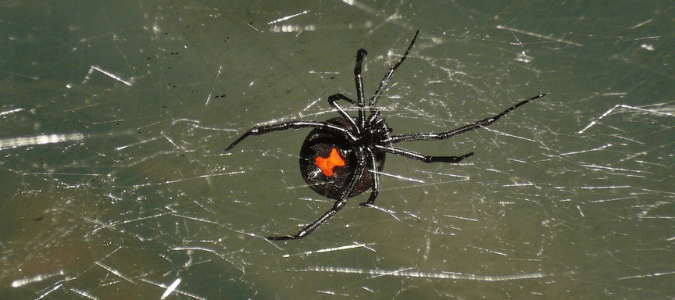
Black Spiders In Florida
As we already mentioned, some spiders that are black and not necessarily dangerous to humans, such as the jumping spider. However, the black widow spider can be found in Florida. This is one of the scariest home pests because they pose a serious health risk to you and your family. While a person can die from a black widow bite, those that seek prompt medical attention generally recover.
Unfortunately, we have two types of black widow spider here: the southern black widow and the northern black widow.
The southern black widow is the most common of the two varieties. This spider is a glossy black color with an hourglass marking on the underside of its abdomen. The northern black widow looks very similar to the southern black widow. However, instead of an hourglass shape, this spider has two red triangles and a row of red spots on top of its abdomen. Both of these spiders have a large, circular abdomen and long, spiny legs.
Black widows are shy creatures, and don’t move easily. These arachnids prefer storage areas and other protected parts of your home, including garages, attics and sheds. Bites usually only occur when one of their cobweb-liked webs is accidentally disturbed.
The false black widow spider is very common in Florida homes. If you notice the spider is more of a dark brown with pale markings, it is likely not one of the dangerous widows we have already described. To be on the safe side, call in a pest control professional if you see a spider that looks like a black widow—it’s not worth risking your health over.
Preventing Unwanted Encounters
Whether a spider is a health concern or not, many homeowners would prefer to steer far away.
As far as prevention goes, a few easy measures you take can make your property less attractive to all spiders and help you avoid a bite include:
- Reduce potential nesting sites by clearing wood and brush.
- Keep plant life from reaching your exterior walls.
- Seal the cracks and seams of your home.
- Clear clutter from inside dark areas of your home.
- Sweep and vacuum spiders and webs regularly.
- Wear leather gloves when working in your yard.
- Place sticky traps in places you have seen spiders to monitor the population.
When you’ve exhausted those options to no avail, professional advice on spider control options is probably your best bet.
We have covered two types of spiders you need to watch out for already. However, are there any more? Are spiders in general dangerous? Keep reading to learn more.
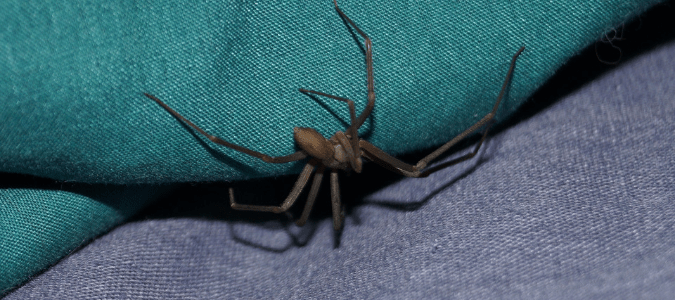
Are Spiders Dangerous?
Of all the household bugs in Florida, spiders can be the scariest. However, arachnids generally keep to themselves. There aren’t really any scenarios in which a spider will attack a human unprovoked. And even the (very few) species most dangerous to humans would prefer flight over fight—which is why they tend to live in the shadows and hide.
If you handle a spider, keep in mind even if its venom isn’t toxic to humans, their bite can still be painful, and could draw blood. If you are bitten by a spider that’s considered harmless, it’s important to still clean the wound like you would any other scratch or cut.
Although not all spiders are dangerous to humans, almost all spiders are venomous. The purpose of their venom is to subdue their prey prior to feeding. Because we’re so much bigger than their typical insect prey, most spiders’ venom doesn’t cause us much harm.
While many people believe that black widow spiders are the only spiders you have to watch out for, as we already mentioned, there are several different species of venomous spiders here in Florida, including different colored widow spiders and recluse spiders.
Identifying Venomous Spiders In Florida
- The red widow: The red widow has a black abdomen and a reddish-orange head, thorax and legs. This species usually has one or two small red marks on its belly, as opposed to the hourglass marking.
- The brown widow: Although its name might indicate otherwise, the brown widow can be anywhere from light gray to light brown to black. A brown widow can have black, white, red or yellow markings on its abdomen. On the other side of its abdomen, you will see an orange or yellow hourglass.
- The brown recluse: These spiders are light brown, sandy brown or a dark brown, and have a distinctive violin-shaped marking in the center of their body.
Any time a person is bitten by one of these species, the victim should seek immediate medical attention.
Note that due to Florida’s temperate climate, all of the types of spiders you want to keep away—with the notable exception of the northern black widow—are out and about all year long.
Another spider that tends to frighten us due to its intimidating size that isn’t harmful is the banana spider.
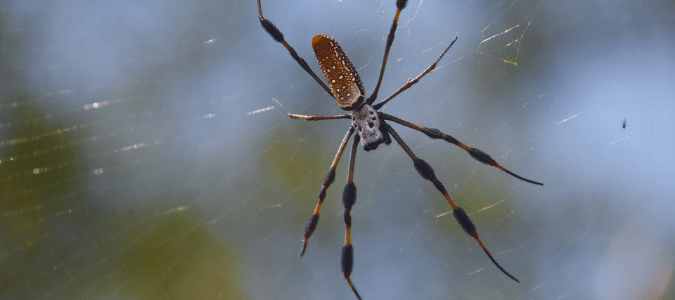
Banana Spiders In Florida
Also commonly known as golden silk spiders, these orb weavers can build webs up to three feet wide. Many homeowners are frightened of this arachnid due to its abnormally large size. A banana spider’s body grows up to two inches long—and that’s not taking their legs into consideration! Females will be bigger than males, growing to be as large as five inches in length. As a matter of fact, female banana spiders are the largest spider in Florida.
Males and females look strikingly different. Females have yellow spots with a light orange or tan abdomen, while the males are much smaller in size and a dark brown color. The females’ legs are yellow or brown with black furry tufts.
Banana spiders can usually be found at the edge of wooded areas or near light poles in more urban settings. New generations of hatchlings grow to maturity throughout spring and continue maturing into the late summer to early fall.
These spiders are rather shy, but if provoked, can leave a victim with a painful. Thankfully, its venom doesn’t have much of an impact on humans.
If you start seeing spiders in increased numbers inside, you likely want some tips on how to control the population.
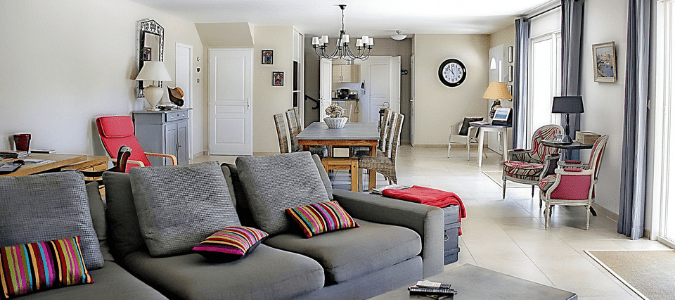
How Do You Get Rid Of Spiders In Your House And Yard?
Previously, we shared quick tips on how to avoid being a prime location for spiders to take up residence. Now, we want to provide a bit more detail on how you can treat your property–both DIY-style and with professional help, if desired.
Educate Yourself
Learn to recognize potentially dangerous species and know where they are likely to be. If you need to work in spider-prone areas, wear gloves to reduce your chances of being bitten.
Reduce Potential Nesting Sites
Make sure firewood is stored away from the house, and prune back trees and shrubs so they don’t touch the house. This will discourage spiders from building their webs along your exterior walls. Rock piles, brush, high weeds, tall grasses and discarded human-made items make great spaces to build webs as well.
Update Your Outdoor Lighting
Direct light away from doorways, and use yellow bug lights whenever possible so that you attract fewer insects near your home that can encourage a spider to stick around.
Seal Cracks And Gaps Around Your Home
Keep spiders outdoors by installing or repairing weather stripping around doors and windows. Seal and caulk around lighted doors and windows, where the insects they feed on are likely to gather.
Clear The Clutter
Seal cardboard boxes with durable, wide tape along all seams. Plastic containers should have tight-fitting lids. Recycle or donate storage containers that you are unable to close and seal.
Sweep And Vacuum Regularly
Sweep away webs from high and low corners of the room. Vacuum up the spiders and their webs from behind objects, under tables and on walls and ceiling corners.
If you take all these steps and still find you are seeing more unwanted arachnid guests than you’d prefer, enlist a pest professional to determine if there is any factors unique to your property that might be making you more vulnerable to spider activity. You can also choose to have regular pest control service calls if you would rather not deal with spiders in your home.
ABC Is Your Full-Service Pest Control Provider
The simple truth is that most of us have neither the time nor expertise to get rid of these uninvited guests on our own, whether they are spiders or a host of other common household invaders. If you’re dealing with an infestation, or even if you want help with identification, trust the professionals at ABC Home & Commercial Services. Our experts can determine how and why spiders are making your residence theirs, propose a plan to reduce the population and give you specialized advice on how to keep them away in the future.